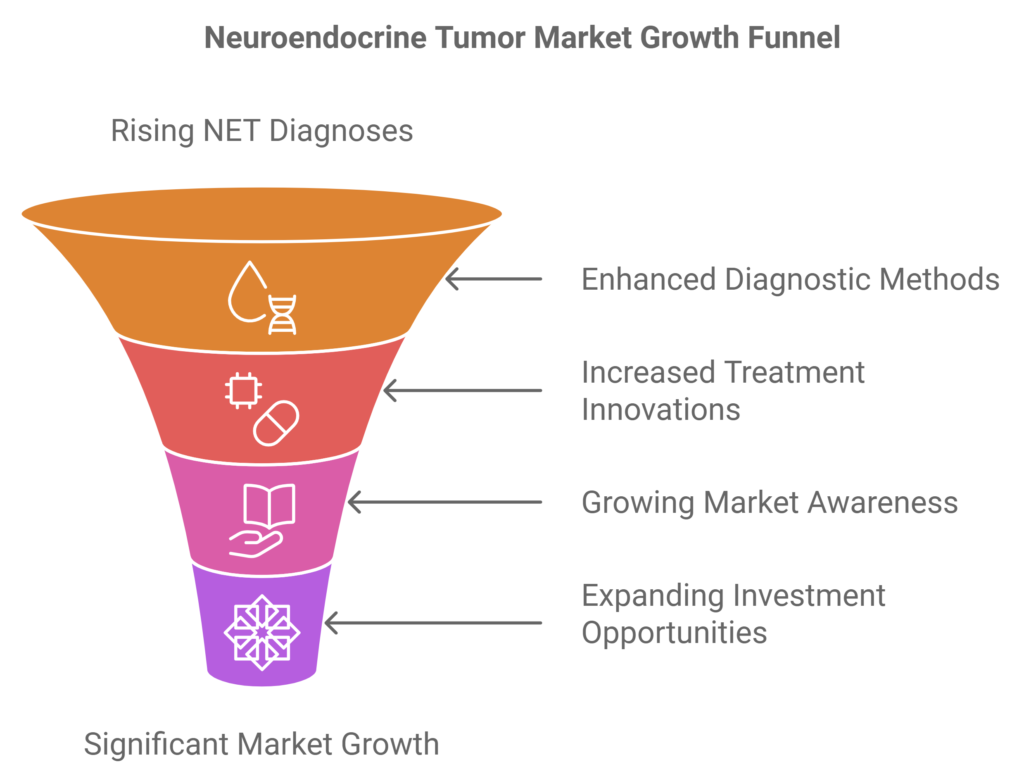Introduction
The market for neuroendocrine tumors (NETs) is experiencing explosive growth, with projections estimating its valuation to reach approximately USD 6.94 billion by the year 2030. This remarkable increase underscores the rising incidence of NETs, which are unusual types of tumors that arise from neuroendocrine cells—cells that have characteristics of both nerve and endocrine cells. These tumors can develop in various organs, including the pancreas, lungs, and gastrointestinal tract, and are known for their diverse biological behavior.
Neuroendocrine tumors are often classified by their origin and can be either functioning or non-functioning. Functioning NETs secrete hormones that can lead to specific syndromes, while non-functioning NETs typically do not produce any active hormones but can still have significant impacts on health. As the medical community’s understanding of these tumors evolves, the importance of early detection and effective treatment strategies becomes increasingly clear. The surging prevalence of NETs has necessitated enhanced research efforts, leading to advances in diagnostics and therapeutic approaches.
The significance of this increasing prevalence in the healthcare landscape cannot be overstated. As awareness of NETs grows among both healthcare practitioners and patients, there is a concomitant rise in the demand for innovative treatment options and supportive care solutions. Additionally, the expanding pipeline of drugs catering to NETs, coupled with increasing investments in targeted therapies, suggests a paradigm shift in how these tumors are approached in clinical settings. This emerging market landscape presents a wealth of investment opportunities for stakeholders looking to engage in a rapidly evolving field that promises considerable advancements in healthcare outcomes for affected individuals.

Market Dynamics: A Perfect Storm for Growth
The neuroendocrine tumors (NETs) market is experiencing significant growth, fueled by a confluence of factors that are driving up demand and creating numerous investment opportunities. A notable factor contributing to this growth is the alarming rise in the diagnosis of NETs. This increase has drawn greater attention to these often-overlooked tumors, leading to heightened awareness among both healthcare professionals and patients. Consequently, the growing incidence is translating into a larger patient population seeking innovative and effective treatment options, thus expanding market potential.
Shifts in diagnostic methodologies also play an essential role in enhancing the growth prospects of the NETs market. Advancements in imaging technologies, such as functional imaging and genetic profiling, have improved the accuracy and speed of NET diagnoses. These innovations not only facilitate earlier detection but also enable more personalized treatment approaches, offering patients improved outcomes. Furthermore, the increased utilization of liquid biopsies represents a transformative change in how NETs are diagnosed and monitored, thereby boosting overall market dynamics.
Raising awareness and educational campaigns surrounding NETs are instrumental in combating the stigma associated with these tumors. Increased understanding among patients and caregivers can lead to timely consultations with healthcare providers, ultimately contributing to a more favorable prognosis through early intervention. Coupled with this awareness is the rapid advancement in treatment options, driven by ongoing research and developments in targeted therapies, immunotherapies, and other novel treatment strategies. These innovations not only provide new avenues for patient management but also attract significant investment into the NETs market, further underscoring the potential for growth.
In summary, the convergence of rising diagnoses, the evolution of diagnostic methods, enhanced public awareness, and breakthroughs in treatment innovations present a perfect storm for the growth of the neuroendocrine tumors market.

Market Segmentation: A Diversified Landscape
The neuroendocrine tumors (NETs) market presents a complex landscape characterized by various classifications and treatment modalities. NETs can be primarily categorized into two segments: functional and non-functional types. This classification is significant as it influences not only the approach to treatment but also the prognosis and management strategies adopted by healthcare providers.
Functional NETs are those that secrete hormones and other bioactive substances, leading to distinct syndromes based on the hormones produced. Common subtypes include insulinomas, gastrinomas, and vasoactive intestinal peptideomas, each of which necessitates targeted therapeutic strategies. Treatment for functional NETs typically involves somatostatin analogs, which inhibit hormone secretion and address the symptoms associated with hormone excess. These agents, such as octreotide and lanreotide, are crucial for managing conditions arising from excessive hormone production.
On the other hand, non-functional NETs do not produce measurable hormonal activity but can still lead to significant morbidity and mortality. These tumors are often diagnosed at later stages due to their insidious nature and lack of overt symptoms. Treatment options for non-functional NETs may involve targeted therapies, including everolimus and sunitinib, which focus on inhibiting tumor growth and proliferation, along with traditional chemotherapy in advanced cases. The choice of therapy generally depends on the tumor’s grade, location, and metastasis status.
This diversified treatment strategy underscores the importance of personalized medicine in the management of NETs. Each patient’s case is evaluated for its unique characteristics, leading to tailored treatment regimens. As the NETs market continues to grow, understanding the segmentation between functional and non-functional types will be crucial for stakeholders aiming to invest and innovate within this expanding field.
Geographical Dominance: North America’s Leading Position
The geographical landscape of the neuroendocrine tumors (NETs) market reveals a significant dominance of North America, primarily due to a myriad of influential factors. One of the foremost contributors to this prominence is the advanced healthcare infrastructure prevalent in the region. The United States and Canada boast a well-established network of hospitals, research facilities, and specialized cancer treatment centers that facilitate comprehensive care for patients with NETs. This infrastructure not only supports early diagnosis but also promotes effective management and treatment protocols tailored to this particular cancer type.
Moreover, the substantial spending on cancer treatment within North America plays a critical role in maintaining its leading position in the NETs market. The healthcare systems in these countries prioritize oncology research and the development of innovative therapies, enabling access to the latest treatment modalities for neuroendocrine tumors. This financial commitment results in improved patient outcomes and fosters an environment conducive to clinical trials, significantly broadening the therapeutic landscape. The collaboration between public healthcare institutions and private sectors attracts investments aimed at enhancing research efforts, thereby reinforcing the region’s standing as a leader in cancer care.
Additionally, the availability of cutting-edge technologies further supports North America’s dominance in the neuroendocrine tumors market. The integration of advanced diagnostic imaging techniques, minimally invasive surgical options, and targeted therapies has transformed treatment protocols, improving the quality of care delivered to patients. With continuous investments in biotechnology and medical devices, healthcare providers are better equipped to address the complexities associated with NETs. Together, these elements create a robust ecosystem that not only addresses the needs of patients but also cultivates an environment ripe for innovation and investment in the field of neuroendocrine tumors.
Future Outlook: A Lucrative Market on the Horizon
The neuroendocrine tumors (NETs) market is projected to experience significant growth in the coming years, driven by an estimated compound annual growth rate (CAGR) of 10.4% from 2024 to 2031. This robust growth is attributed to multiple factors, including advancements in medical treatments, increasing awareness and diagnosis rates, and a growing demand for innovative therapeutic solutions. The increasing prevalence of NETs, combined with the rising elderly population, further fuels the urgency for effective treatment options, thereby catalyzing market expansion.
Technological advancements play a pivotal role in shaping the future of the NETs market. Breakthroughs in diagnostic techniques, such as improved imaging technologies and biomarker discovery, have enhanced the accuracy of NET detection. Moreover, the integration of artificial intelligence and machine learning into clinical practices contributes to more precise treatment plans tailored to individual patient needs. These innovations not only increase the speed of diagnosis but also improve patient outcomes, laying the groundwork for further investment opportunities within the sector.
Additionally, the development of targeted therapies and personalized medicine is set to revolutionize the treatment landscape for neuroendocrine tumors. Biopharmaceutical companies are increasingly focusing on research and development to produce more effective therapeutics that minimize side effects and maximize efficacy. With ongoing developments in immunotherapy and other novel treatment modalities, the NETs market is likely to see new entrants and increased competition, which can drive prices down and ultimately benefit patients.
In conclusion, the neuroendocrine tumors market stands at a critical juncture, with the potential for significant growth as it adapts to technological advancements and shifting treatment paradigms. Stakeholders and investors who recognize these trends are poised to capitalize on the lucrative opportunities that lie ahead in this burgeoning market.
Investment Potential: Capitalizing on the NETs Boom
The neuroendocrine tumors (NETs) market is experiencing significant growth, making it an attractive area for investors seeking opportunities in the biopharmaceutical sector. With an increasing prevalence of neuroendocrine tumors and a rising demand for innovative therapies, the market has become a focal point for both established and emerging companies. Investors are presented with various compelling reasons to consider this growing domain.
Firstly, the global neuroendocrine tumor therapeutics market is projected to expand substantially due to advancements in treatment modalities and an increasing emphasis on precision medicine. The expansion is driven by the growing recognition of the importance of targeted therapies and personalized treatment plans. As a result, companies engaged in developing these innovative solutions are poised to benefit from increased funding, research collaborations, and market share. Notable players in the NETs landscape include Lexicon Pharmaceuticals, Blue Earth Diagnostics, and Ipsen, all of which are developing cutting-edge therapeutics that cater to the specific needs of NET patients.
Moreover, the investment potential in NETs is enhanced by the favorable regulatory environment. The increasing speed at which new treatments are being approved, coupled with the growing advocacy for patient access to novel therapies, works in favor of investors looking to enter this sector. Furthermore, ongoing clinical trials and research initiatives provide valuable insights and bolster investor confidence in the viability of NET-focused companies.
In light of these factors, it is evident that the neuroendocrine tumors market offers numerous investment opportunities. Potential investors should closely monitor this sector, considering factors such as emerging clinical trials, research advancements, and the development of innovative treatments. By capitalizing on the NETs boom, investors can position themselves advantageously in a rapidly evolving market, poised for substantial financial returns.
Call to Action for Various Stakeholders
The rapidly evolving landscape of neuroendocrine tumors (NETs) presents substantial investment opportunities for current and prospective investors. As the market for NETs continues to grow, investors must explore and understand the dynamics that influence this sector. Potential financial backers are encouraged to conduct thorough research into various companies involved in the development of NET treatments and leverage this knowledge to make informed investment decisions. Collaborating with industry experts or joining forums focused on NETs may provide additional insights into emerging trends and technologies, leading to more strategic investment choices.
For healthcare professionals, remaining informed about the latest advancements in the field of neuroendocrine tumors is paramount. The rapid progress in diagnostics, therapies, and clinical trials underscores the need for continuous education. Medical practitioners should actively seek out the latest research findings, attend relevant conferences, and participate in seminars to ensure they remain abreast of cutting-edge techniques and treatment paradigms. Involvement in professional networks or medical associations dedicated to NETs can further enrich their understanding and keep them updated on innovations that can enhance patient care.
Patients diagnosed with neuroendocrine tumors are encouraged to take an active role in their treatment journey. This includes researching and seeking out legitimate resources to learn more about the available treatment options and the ongoing efforts in the advocacy space. Engaging with support groups and networks can not only provide vital information but also a sense of community and empowerment. Patients should be proactive in discussing their treatment options with healthcare providers and utilizing educational resources to better understand their diagnosis, which is essential for making informed decisions regarding their healthcare plan.
Conclusion
The neuroendocrine tumors (NETs) market is experiencing a significant surge, driven by the rising incidence of these cancers and the advancements in treatment options. As healthcare professionals and stakeholders in the oncology field become increasingly aware of the unique characteristics of neuroendocrine tumors, there is an emerging demand for specialized therapies that can target these conditions more effectively. This growing awareness is paramount to improving patient outcomes and enhancing the quality of care provided.
Furthermore, the recent advancements in treatment modalities, including targeted therapies and novel immunotherapies, have opened new avenues for managing NETs. These innovations not only increase survival rates but also enhance the overall patient experience by offering more tolerable and efficient treatment regimens. The commitment from pharmaceutical companies to develop and market these tailored therapies presents numerous investment opportunities, making this a pivotal time for stakeholders looking to contribute to and benefit from the burgeoning NETs landscape.
As we look to the future, it is clear that the neuroendocrine tumors market holds great promise. The alignment of research, clinical practice, and patient advocacy serves to propel the growth of this market further. Each stakeholder, whether they are investors, healthcare providers, or researchers, has a crucial role in facilitating this progress. Interested parties need to engage proactively, keeping abreast of the latest developments and exploring strategic collaborations, to maximize their impact in the evolving NETs ecosystem. Taking decisive action now could lead to substantial rewards shortly, particularly in a market poised for robust expansion.
Resources and Further Reading
For readers interested in diving deeper into the field of neuroendocrine tumors (NETs) and understanding the dynamics of the market, a variety of valuable resources, reports, and educational materials are available. These resources cater to different audiences, including investors, healthcare professionals, and patients.
A key resource for up-to-date information is the American Cancer Society’s website, which offers comprehensive details on neuroendocrine tumors, their classifications, symptoms, and treatment options. Similarly, the National Cancer Institute provides a wealth of scientific articles and research findings relevant to the biology and management of NETs.
Investors looking to understand market trends and dynamics can benefit from detailed market research reports published by companies like Grand View Research and Market Research Future. These reports often cover aspects such as market size, forecasts, competitive landscape, and investment opportunities specifically within the neuroendocrine tumors sector.
Moreover, journals such as ‘Cancer’ and ‘Journal of Clinical Oncology’ regularly publish peer-reviewed studies on neuroendocrine tumors that present the latest findings in treatment efficacy, patient outcomes, and innovative research. Accessing such articles can greatly enhance the knowledge base required for informed decision-making in clinical practice or investment strategies.
Networking with professional organizations, such as the North American Neuroendocrine Tumor Society (NANETS) or the European Neuroendocrine Tumor Society (ENETS), can also provide insights into current clinical practices and aid collaboration for ongoing research. These organizations often have online resources, webinars, and conferences that can be invaluable for expanding one’s understanding.
Lastly, patient advocacy groups like the Neuroendocrine Cancer Awareness Network (NCAN) supply educational materials and support networks for those affected by NETs, contributing to better patient outcomes and awareness within the community.
Expert Insights and Opinion
The neuroendocrine tumors (NETs) market is experiencing significant growth, driven by advancements in treatment modalities and an increase in awareness surrounding these often misunderstood malignancies. Experts in the field have underscored the importance of early detection and personalized treatment plans, which have been shown to dramatically enhance patient outcomes. Dr. Jane Thompson, an oncologist specializing in NETs, notes that “the evolution of therapies, especially targeted treatments and immunotherapies, is transforming the landscape of NET management.” This indicates a shift towards more tailored approaches that are proving more effective compared to traditional therapies.
Furthermore, the market potential remains promising as numerous pharmaceutical companies are investing in research and development. Analysts predict that the increasing incidence of NETs, along with heightened public awareness, will drive both clinical advancements and market growth. Dr. Paul Lee, a market analyst, emphasizes that “the convergence of science and technology, particularly in molecular diagnostics, is unlocking new avenues for treatment that were previously unexplored.” This progress reinforces the need for ongoing investment in NETs research, leading to innovations that can address unmet medical needs.
In addition, expert opinions suggest that collaboration between biotechnology firms and regulatory bodies is essential for accelerating the approval of new therapies. By streamlining clinical trial processes and enhancing data-sharing mechanisms, these partnerships are crucial to fostering innovation. Dr. Emily Cho, a regulatory affairs specialist, points out that “an efficient regulatory pathway will not only benefit pharmaceutical companies but also support patients in gaining access to cutting-edge treatments without unnecessary delays.”
As we look to the future, the neuroendocrine tumors market is poised for expansion, driven by both clinical advancements and strategic investments. This dynamic environment offers numerous investment opportunities for stakeholders, from established pharmaceutical firms to innovative startups, all of which are eager to make a lasting impact in the treatment landscape for NETs.
Citations:
[1] https://www.coherentmarketinsights.com/market-insight/neuroendocrine-tumors-treatment-market-129
[2] https://www.globaldata.com/store/report/neuroendocrine-tumors-market-analysis/
[3] https://www.databridgemarketresearch.com/reports/global-neuroendocrine-tumors-market
[4] https://www.mordorintelligence.com/industry-reports/neuroendocrine-tumor-treatment-market
[5] https://www.skyquestt.com/report/neuroendocrine-tumors-treatment-market
[6] https://www.futuremarketinsights.com/reports/neuroendocrine-carcinoma-market
[7] https://www.giiresearch.com/report/tbrc1427922-neuroendocrine-tumor-treatment-global-market.html
[8] https://straitsresearch.com/report/neuroendocrine-tumors-treatment-market
Latest Posts:
- Tapping into the $6.94 Billion Neuro-Endocrine Tumor Market: Is This the Next Groundbreaking Investment Opportunity?
- Future Market Value: $7.8 Billion by 2030 | Is the Surgical Sutures Market Set for Explosive Growth?
- The Promising Future of the Global Two-Wheeler Catalytic Converter Market: Trends and Projections for 2024-2028
- $4.5 Billion Potential: Is Insolvency Software Your Next Big Investment?
- $3.76 Billion Opportunity: Uncovering the Growth Drivers of the Global Military Helmet Market

